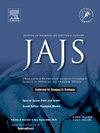Short-Term Results after Reverse Total Shoulder Arthroplasty
Q4 Medicine
引用次数: 0
Abstract
The loss of the shoulder’s center of rotation is caused by massive rotator cuff tears, which can occur with or without arthritis and proximal humerus fractures that are nonunion or malunion. Because anatomical total shoulder arthroplasty cannot provide a stable center of rotation, reverse total shoulder arthroplasty (RTSA) is the appropriate procedure for these indications and in older patients who have primary glenohumeral osteoarthritis. Anatomical total shoulder arthroplasty carries a risk of failure because of the loosening of the glenoid component or cuff tear. The purpose of this study was to determine the short-term outcomes following RTSA in patients who had primary glenohumeral osteoarthritis, acute proximal humerus fractures, malunited or nonunited proximal humerus fractures, and massive cuff tears. This single-arm clinical trial (interventional study) was done in Ain Shams University Hospitals; 16 patients were included who underwent RTSA. Constant score, American Shoulder and Elbow Surgeon score, Visual Analog Scale score, and range of motion (ROM) were the short-term outcomes. Patients with cuff tear arthropathy, irreparable cuff tear with or without glenohumeral arthritis, elderly patients with unreconstructable proximal humerus fracture, proximal humerus fracture malunion or nonunion, and patients with glenohumeral osteoarthritis were included. Patients under the age of 50, as well as those with deltoid muscle dysfunction or injuries to the axillary nerve, were excluded. There were 16 patients in this study, 8 of whom were male and 8 of whom were female. The follow-up period lasted 2 years following surgery, with a mean age of 64.19 years. The study included 7 patients with irreparable cuff tears one of them had associated anterior shoulder instability and recurrent anterior shoulder dislocation. One patient had a neglected shoulder dislocation, two patients had proximal humerus fracture dislocation, two patients had a nonunited proximal humerus fracture, three patients had unreconstructable proximal humerus fracture, and two had glenohumeral osteoarthritis. Not only did RTSA provide good clinical and functional outcomes for the standard indication of a massive cuff tear, but it also proved beneficial for other disorders such as primary glenohumeral osteoarthritis, nonunited fracture, and acute proximal humerus fracture. Among all indications, irreparable cuff tears yielded the highest results; nonunited fractures displayed the least improvement regarding clinical outcomes. Enhancements in the design of prostheses, the expertise of surgeons, and clinical outcomes are crucial to maximize their effectiveness in treating various shoulder disorders.反向全肩关节置换术后的短期效果
肩关节旋转中心的丧失是由肩袖大面积撕裂造成的,可与关节炎或肱骨近端骨折不愈合或愈合不良同时发生。由于解剖型全肩关节置换术无法提供稳定的旋转中心,因此反向全肩关节置换术(RTSA)是适合这些适应症以及患有原发性盂肱关节炎的老年患者的手术。解剖型全肩关节置换术存在因盂骨组件松动或肩袖撕裂而失败的风险。本研究旨在确定原发性盂肱骨关节炎、急性肱骨近端骨折、肱骨近端骨折错合或非错合以及肩袖大面积撕裂患者接受 RTSA 后的短期疗效。 这项单臂临床试验(干预性研究)在艾因-沙姆斯大学医院进行,共有 16 名患者接受了 RTSA 治疗。短期疗效包括恒定评分、美国肩肘外科医生评分、视觉模拟量表评分和活动范围(ROM)。研究对象包括肩袖撕裂关节病患者、肩袖撕裂不可修复且伴有或不伴有盂肱关节炎患者、肱骨近端骨折无法重建的老年患者、肱骨近端骨折愈合不良或未愈合患者以及盂肱骨骨关节炎患者。50岁以下的患者以及三角肌功能障碍或腋神经受伤的患者不在研究范围内。 这项研究共有16名患者,其中8名为男性,8名为女性。随访时间为术后两年,平均年龄为 64.19 岁。研究包括7名肩袖撕裂无法修复的患者,其中一名患者伴有肩关节前侧不稳定和肩关节前侧复发性脱位。一名患者肩关节脱位被忽视,两名患者肱骨近端骨折脱位,两名患者肱骨近端骨折不融合,三名患者肱骨近端骨折无法修复,两名患者患有盂肱骨关节炎。 RTSA不仅为大面积袖带撕裂这一标准适应症提供了良好的临床和功能结果,而且还证明对原发性盂肱骨关节炎、非联合骨折和急性肱骨近端骨折等其他疾病也有益处。在所有适应症中,不可修复的肩袖撕裂的治疗效果最好;非联合骨折的临床效果改善最少。要最大限度地提高假体治疗各种肩部疾病的效果,假体设计、外科医生的专业知识和临床效果的改进至关重要。
本文章由计算机程序翻译,如有差异,请以英文原文为准。
求助全文
约1分钟内获得全文
求助全文
来源期刊

Journal of Arthroscopy and Joint Surgery
Medicine-Orthopedics and Sports Medicine
CiteScore
0.60
自引率
0.00%
发文量
1
期刊介绍:
Journal of Arthroscopy and Joint Surgery (JAJS) is committed to bring forth scientific manuscripts in the form of original research articles, current concept reviews, meta-analyses, case reports and letters to the editor. The focus of the Journal is to present wide-ranging, multi-disciplinary perspectives on the problems of the joints that are amenable with Arthroscopy and Arthroplasty. Though Arthroscopy and Arthroplasty entail surgical procedures, the Journal shall not restrict itself to these purely surgical procedures and will also encompass pharmacological, rehabilitative and physical measures that can prevent or postpone the execution of a surgical procedure. The Journal will also publish scientific research related to tissues other than joints that would ultimately have an effect on the joint function.
 求助内容:
求助内容: 应助结果提醒方式:
应助结果提醒方式:


